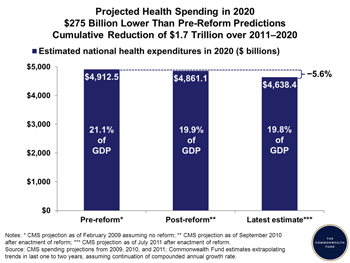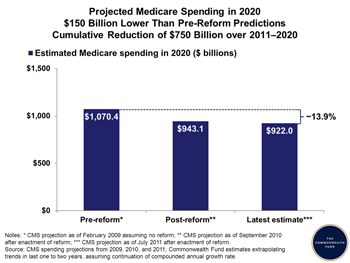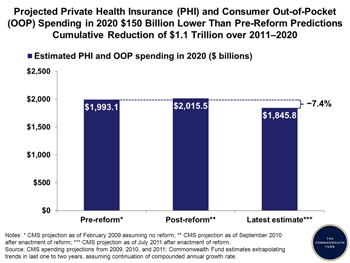Health care spending in 2009 and 2010 grew at the slowest rates in 50 years. This startling news, published in an article by staff of the Centers for Medicare and Medicaid Services (CMS) in Health Affairs, was largely attributed to the shrinking economy.1 Loss of jobs and insurance, slow growth in wages and family incomes, and greater out-of-pocket health care costs have undoubtedly caused uninsured, underinsured, and low-wage workers and their families to forgo care, contributing to the slowdown in health spending. An estimated 9 million people became uninsured when they lost a job with benefits over 2008–10, and they were much more likely than those who did not lose coverage to report delaying needed care.2
Future Spending Lower Than Expected. A major point that has been overlooked in the analysis is that CMS is projecting lower health spending over the rest of the decade. While it is almost certainly the case that the poor economy is having an effect on current spending, the recession doesn’t plausibly explain why projected health spending in 2020 is substantially below estimates made just two years ago. Either the original estimates were too high, or the tectonic plates underlying the health system are beginning to shift in anticipation of new incentives under health reform or in response to health care leaders’ efforts to transform care over the last decade.

CMS's estimates of health care spending through the end of the decade have been steadily falling over the last year and a half. As shown in Exhibit 1, the most recent projection of national health spending in 2020 is $4.6 trillion, or 19.8 percent of gross domestic product (GDP), compared with its projection of $4.9 trillion, or 21.1 percent of GDP, in 2009 in the absence of reform. This represents a $275 billion (5.6 percent) reduction for 2020, compared with pre-reform estimates. Moreover, that projection represents a cumulative reduction of $1.7 trillion over the 10 years from 2011 to 2020.3
This reduction in projected national health spending is particularly important because the pre-reform projection of health care costs was used by the Congressional Budget Office (CBO) and the CMS Office of the Actuary in estimating the cost and impact of health reform. Already, spending is far below the trajectory projected to result from implementation of the Affordable Care Act.4 In fact, reduction in utilization of health services and trims in payment rates under the Affordable Care Act more than offset the projected cost of covering the uninsured.
Projected Medicare spending is even further below original estimates, and provisions in the Affordable Care Act play a major role in the new, lower numbers. As shown in Exhibit 2, Medicare spending in 2020 is now estimated to be $922 billion, which is $150 billion lower than the $1.07 trillion projected by CMS pre-reform. As the Health Affairs authors note, Medicare savings come from Affordable Care Act changes in payment rates for Medicare Advantage plans, home health agencies, and other providers (effective October 1, 2009), fraud and abuse provisions, as well as requirements for prescription drug rebates for Medicare managed care plans (effective January 1, 2010). The official CBO health reform estimates included $397 billion in projected Medicare savings from Affordable Care Act provisions over the 2010–19 period.5 But it would now appear that the reduction in projected Medicare outlays over a 10-year period is almost twice that.
At a minimum, dire predictions that the Affordable Care Act would fail to control costs and, in fact, accelerate spending have not been borne out by the early experience. It now appears that both the costs of covering the uninsured and Medicare spending are substantially below pre-reform estimates.
The Role of Health Care Delivery Reform. While the recession has played an important role in the reduced utilization of health care services, the efforts made over the last decade to transform health care delivery may also have contributed to slower spending growth. Private sector initiatives have been encouraging hospitals and physicians to adopt improved safety methods, reach performance benchmarks, and reorganize care to achieve greater value. Private insurers and Medicaid have begun to pay for care differently, creating opportunities for new models of health care delivery. For almost a decade now, Medicaid programs in 41 states have been supporting the adoption of the patient-centered medical home model of primary care to make care more accessible and reduce trips to the emergency department.6

The Health Information Technology for Economic and Clinical Health (HITECH) legislation enacted in early 2009 is encouraging more hospitals and doctors to make meaningful use of health information technology, including the use of decision-support with appropriateness guidelines for elective procedures for which there has been substantial slowing in spending. The percentage of physicians who have adopted electronic health records doubled from 17 to 34 percent between 2008 and 2011.7 As hospitals and physicians move into the electronic age, duplication of tests is likely to drop and improved care coordination should help prevent avoidable hospitalizations and rehospitalizations, eliminate waste, and reduce inappropriate utilization of services.
The Affordable Care Act has removed financial barriers to preventive care for those covered by private insurance and Medicare, perhaps contributing to the drop in flu-related Medicare hospitalizations in 2010. Closer analysis of utilization trends—by type of service and population group—could lend insight into whether reduced utilization means better care and prevention, or reflects financial barriers to needed care. In other words, the kind of utilization matters: reducing overuse of unneeded services clearly is desirable while underuse of essential services is not.
Factors Affecting Employer and State Spending. Employers' share of health care spending has also slowed—down from 25 percent of total health spending in 2001 to 21 percent in 2010. This change is partly a result of employers shifting more costs to workers through higher deductibles and partly a reflection of higher unemployment. Employers also have been encouraging employees to switch from brand-name to generic drugs by offering lower copayments for the latter, which the Health Affairs article points to as one reason for slower drug spending growth. As brand drug patent protection ends, further slowing may be expected. Some employers are also taking advantage of Affordable Care Act provisions to provide incentives for employees to participate in health promotion activities.8

In addition, small businesses have benefitted from tax credits to help with insurance premiums.9 Up to 16.6 million workers are in small firms eligible for a business health insurance tax credit in 2010 to 2016. As shown in Exhibit 3, CMS projects that in 2020, private health insurance premiums paid by employers and individuals and out-of-pocket costs borne by patients will be $150 billion lower in 2020 than estimated pre-reform, with a cumulative reduction of $1.1 trillion over 2011–20—a savings of 7.4 percent to employers and households.
States in these tough times have been holding the reins on Medicaid provider payment, especially for nursing homes and home health care. Medicaid coverage and spending, however, have increased as states have covered some low-income individuals losing employer coverage and raised hospital payment rates to help them stay solvent.
The economic stimulus legislation also assisted states in weathering the economic contraction through higher federal Medicaid matching rates amounting to $82 billion from October 2008 through December 2010.10 States' share of health spending dropped from 18 percent in 2007 to 16 percent in 2010.11 Federal fiscal relief to states has had the effect of preserving eligibility for Medicaid as well as stimulating the economy and preventing loss of jobs.
Worrisome Trends. The most worrisome cost trend is the increase in health insurance overhead. Health insurance premiums are going up faster than benefit costs, with the net cost of private insurance administration growing 8.4 percent in 2010.12 Under the Affordable Care Act, workers will be eligible for rebates if carriers spend too little on medical costs relative to administration and profits. The Secretary of Health and Human Services and state insurance departments are also now reviewing insurance premium increases in excess of 10 percent. These actions may curb rising health insurance premiums, although this will need to be watched closely over the next few years, as will other sectors such as durable medical equipment, where costs are continuing to increase at rapid rates.
The consolidation of the health care sector is also troubling. While larger health systems may improve care coordination, they may also extract prices from private insurers in excess of competitive market rates.13 Again, this will bear close scrutiny and possible further action.
Conclusion. There is much to celebrate in this historic slowdown in health care costs. After a half-century of steadily increasing as a share of the economy, the health sector is now increasing at a more affordable rate. Further investigation of the root causes of this slowdown is certainly warranted.
It will be particularly important to deploy all of the tools in the Affordable Care Act to build on this beginning to ensure that beneficial services are provided while duplicative, preventable, and unnecessary services are eliminated. Attention should be given to assessing the impact of new methods of organizing the delivery of health care services, adoption of electronic information systems, and health reform provisions that will test and reward health care organizations that are accountable for achieving better outcomes, higher quality, and lower costs.
Staying the course toward a high performance health system shows promise of at long last bending the health care cost curve. It offers a far more promising approach to containing health care costs than increasing deductibles, cutting benefits, and shifting more of the financial burden of health insurance premiums and medical bills to working families and elderly and disabled Medicare beneficiaries.
Acknowledgements
The author would like to thank Christine Haran, Martha Hostetter, Kristof Stremikis, Gary Reed, Anthony Shih, Sara R. Collins, Stuart Guterman, Anne-Marie Audet, Melinda Abrams, David Blumenthal, M.D., and Michael Chernew.
1 A. Martin, D. Lassman, B. Washington et al., and the National Health Expenditure Accounts Team, “Growth in US Health Spending Remained Slow in 2010; Health Share of Gross Domestic Product Was Unchanged from 2009,” Health Affairs, Jan. 2012 31(1):208–19.
2 M. M. Doty, S. R. Collins, R. Robertson, and T. Garber, Realizing Health Reform's Potential—When Unemployed Means Uninsured: The Toll of Job Loss on Health Coverage, and How the Affordable Care Act Will Help (New York: The Commonwealth Fund, August 2011).
3 A. Sisko, C. Truffer, S. Smith et al., “Health Spending Projections Through 2018: Recession Effects Add Uncertainty to the Outlook,” Health Affairs, Mar./Apr. 2009 28(2):w346–w347; A. Sisko, C. Truffer, S. Keehan et al., “National Health Spending Projections: The Estimated Impact of Reform Through 2019,” Health Affairs, Oct. 2010 29(10):1933–41; and S. 4 Keehan, A. Sisko, C. Truffer et al., “National Health Spending Through 2020: Economic Recovery and Reform Drive Faster Spending Growth,” Health Affairs, Aug. 2011 30(8):1594–1605. The out-year projections do not yet reflect the lower rate of spending growth in the most recent January 2012 release.
4 R. Foster, “Estimated Financial Effects of the Patient Protection and Affordable Care Act, as Amended,” analysis dated April 22, 2010.
5 D. M. Cutler, K. Davis, and K. Stremikis, The Impact of Health Reform on Health System Spending (New York: The Commonwealth Fund, May 2010).
6http://www.nashp.org/med-home-map
7 Office of the National Coordinator for Health Information Technology, HITECH Progress Fact Sheet, http://www.healthit.gov/achieving-MU/.
8 Patient Protection and Affordable Care Act, section 2705.
9 S. R. Collins, K. Davis, J. L. Nicholson, and K. Stremikis, Realizing Health Reform’s Potential: Small Businesses and the Affordable Care Act of 2010 (New York: The Commonwealth Fund, September 2010).
10 A. Martin, D. Lassman, B. Washington et al., Jan. 2012.
11 Ibid.
12 Ibid.
13 J. Robinson, “Hospital Market Concentration, Pricing, and Profitability,” The American Journal of Managed Care, June 2011 17(6):241–48.



